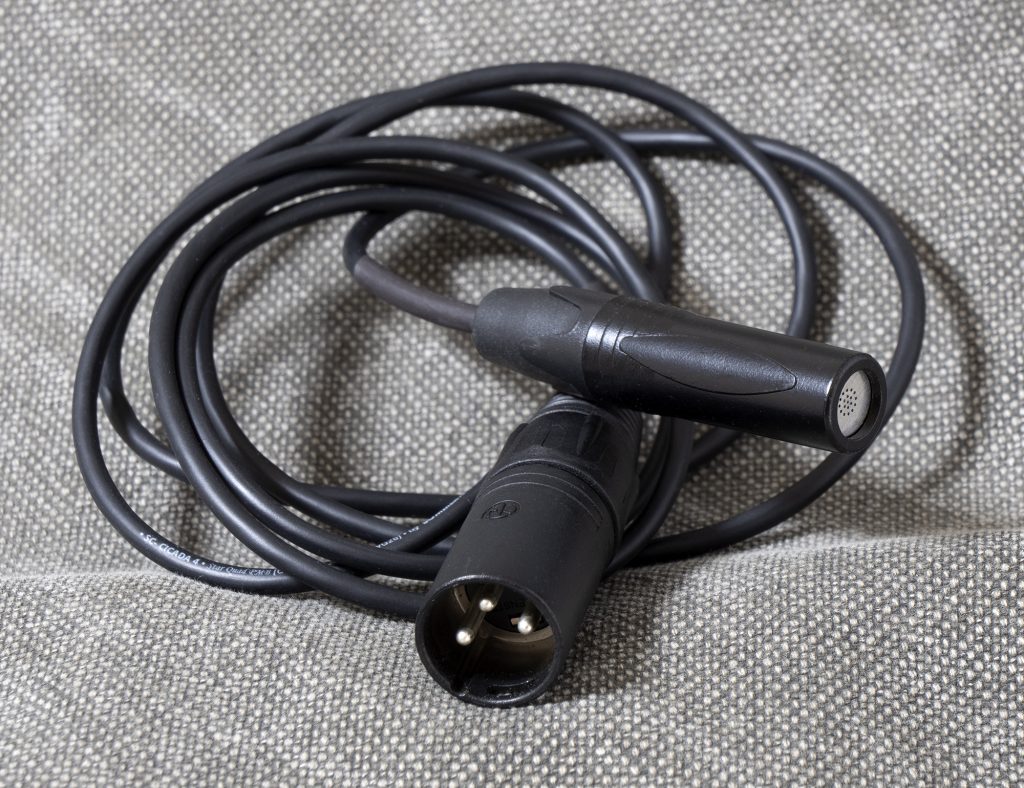
Budget omni mics using the same very affordable 10mm capsules have been made for some years by small manufacturers, most notably FEL Communications Ltd (Micboosters) in the UK and LOM in Slovakia. As I discussed in a previous post these use the Primo EM172 and, more latterly, the EM272 capsules: FEL/Micboostsers make this clear (and sell the bare capsules too), while LOM are rather more coy about what is inside their mics.
Intriguingly, a very similar looking – and similarly low-priced – mic has been introduced by another of these small-scale makers, again using a pre-made electret capsule: like LOM, Immersive Soundscapes in France (a one-man band – or autoentrepreneur) is equally reticent about what capsule is inside the mic, although the website is at pains to say it is equivalent to an EM272, but is not one! The specs match those of the AOM-5024L-HD-R capsule used especially in the US, but let’s hope that Immersive Soundscapes clarify the matter in due course [Edit: Philippe at Immersive Soundscapes confirmed this was case on 5.6.2022]. Certainly the specs, while close to the Primo capsule (including the respectable self-noise of 14 dBA), are different in one significant regard: the sensitivity is -24dB vs the EM272’s -28dB (with the maximum sound pressure level, or SPL, reduced from 122dB to 110dB). The full specs are given on the Immersive Soundscapes website.
Interested in hearing the different capsule, I asked Philippe at Immersive Soundscapes to send me a pair to test and review, which he was kind enough to do: in this case it was a pair of the P48/XLR mics (which retail for 85,00 €), but he also sells a PIP version with a 3.5mm stereo plug (75,00 €). The mics are well put together, within what looks to be the barrel of a 1/4″ (6.35mm) phono plug: an unbranded equivalent to the Neutrik NPX3. The slightly tapered barrel (around 13mm diameter) is rather small for off-the-peg shock mounts and windshields, so Philippe provides a push-on plastic collar that beefs up the diameter to 18.25mm. The mics are wired with about 1.5m of Sommer’s diminutive starquad (SC-Cicada 4) cable, and a Neutrik XLR plug. Physically then the mics are rather like the LOM Uši Pro mics, and are in contrast with the smaller housing of the Micbooster Clippy mics (which are smaller and lighter, effectively over-sized lav mics). The EarSight mics lack the mini-XLR connectors of the LOM Uši Pro mics, although I’m not certain how much use these are with such small mics.
So much for the look and feel of the mics: on to tests!
Interference
One of the annoying features of the Primo EM272 capsule is its susceptibility to interference. Indeed, Nick Roast at Micboosters even publishes a caveat to that effect: I have seen no such info on the LOM website and am not certain how their mics perform in this regard. Certainly, the problem is not one of the Clippy mics, but, rather, the capsule itself: making up mics from the bare EM272 capsules, I have found the problem with wifi interference, most obviously with the Rode Wireless GO ii. Given that this is the sort of thing recordists will plug a small mic into, this is a real problem. The EM172 (no longer in production) doesn’t have the issue and I’m very pleased to note that the EarSight mic is also immune to the Rode Wireless GO ii (and, indeed, mobile phone-based RFI). Good news indeed!
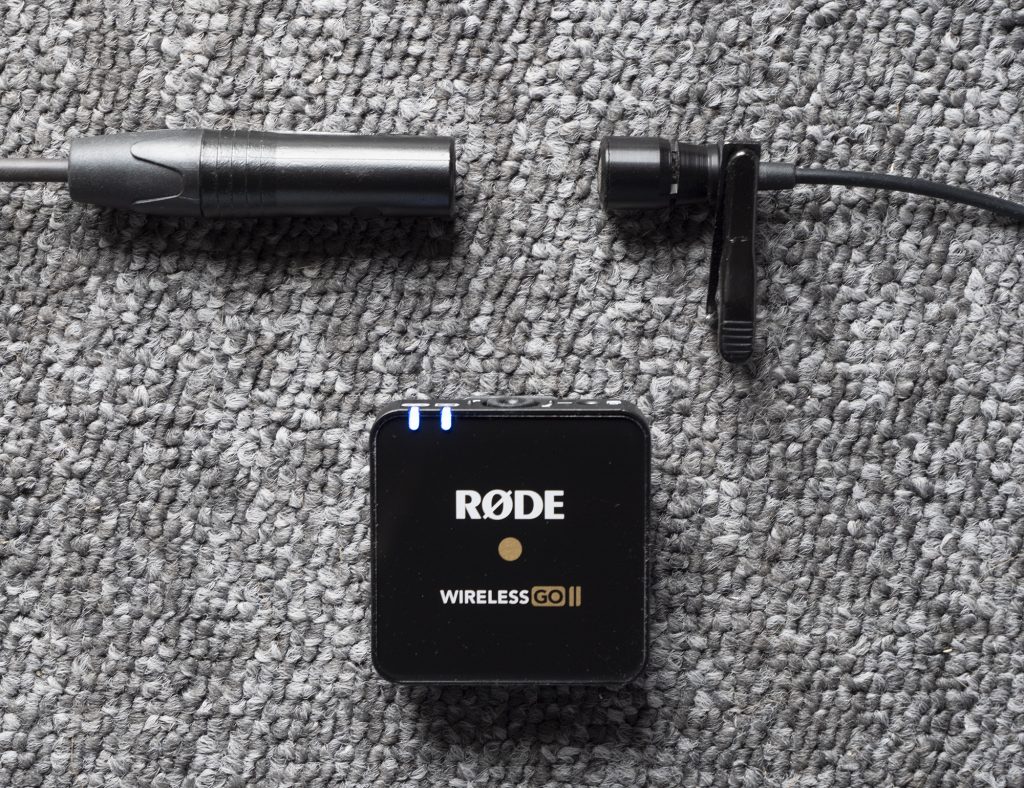
Sound tests
And, finally, plugging in the EarSight mics to Sound Devices MixPre-3, for some field tests. Needless to say, all the test recordings are without any effects, processing etc. First off, it was good to hear how the stereo pair handled some typical ambience – very much the target use of the mics.
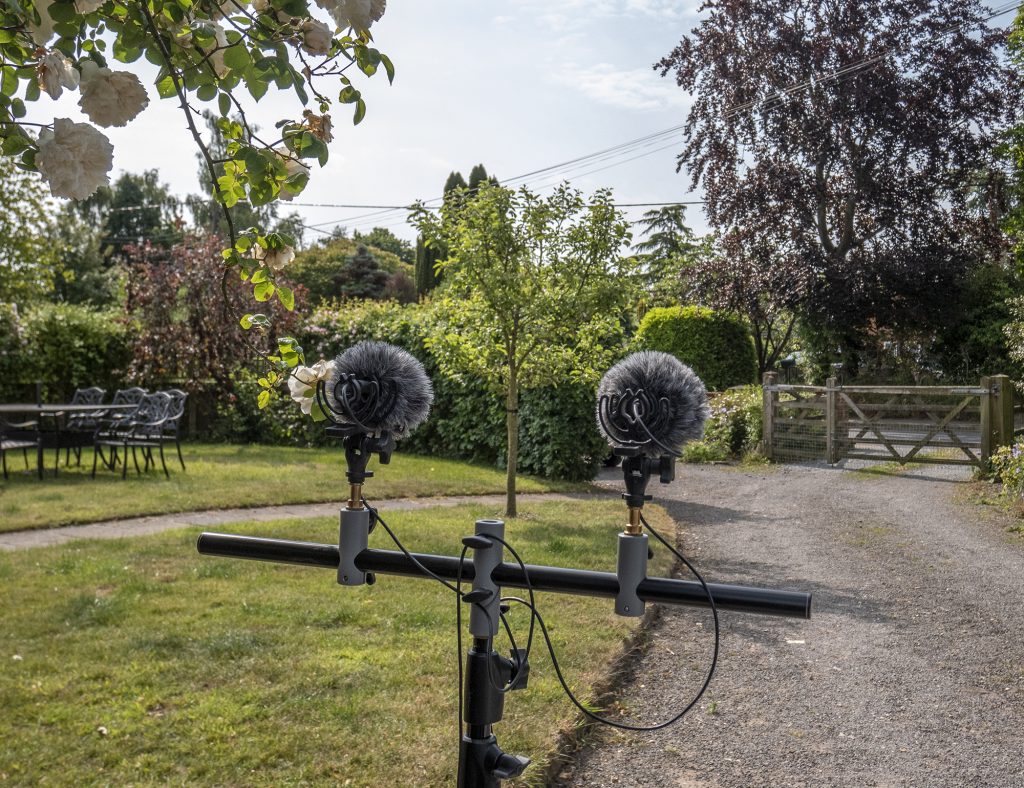
So here’s an initial test of a supposedly quiet village street ambience. The 80Hz low-cut filter was enabled on the MixPre-3 to remove the excessive bass (for which, read on).
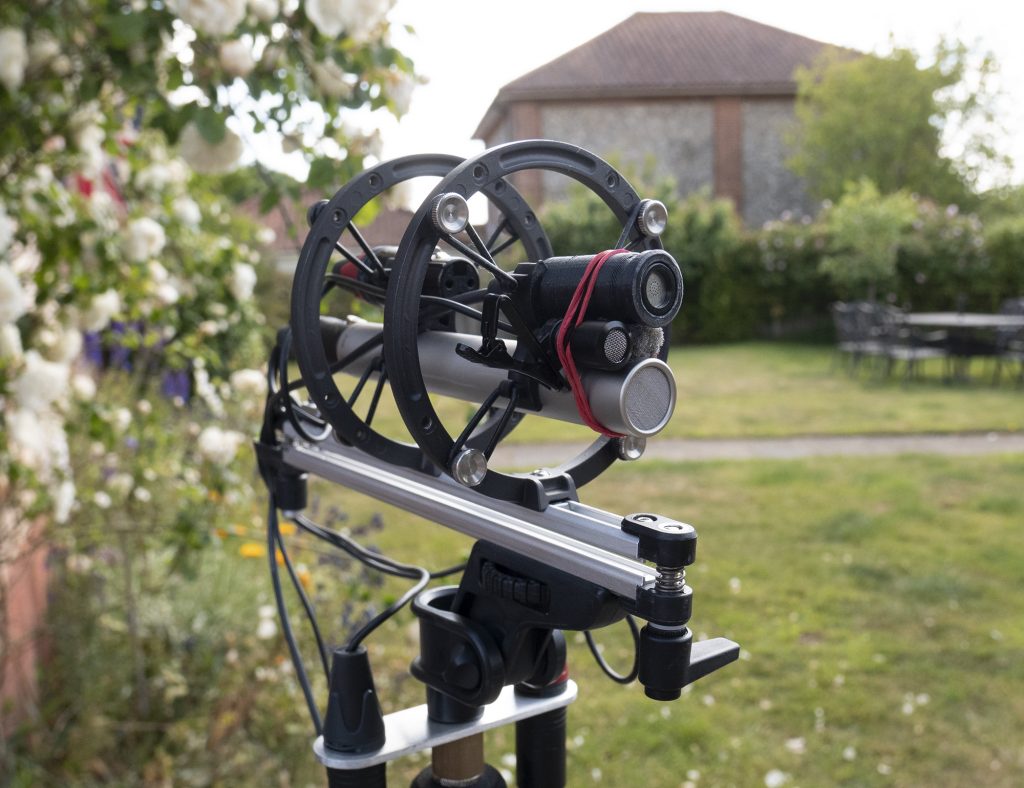
Exploring the low frequency response of the mics rather more, here are some comparative (mono) tests, with three mics (the EarSight, an EM272 mic in the form of a Micbooster Clippy, and a Rode NT55 with the omni NT45-O capsule). I recorded various tracks, but this one, with a background engine (I think a tractor or JCB several hundred meters/yards away) and then an aeroplane is quite instructive.
The extended bass of the two 10mm capsules (i.e. the EarSight and the EM272 in the Clippy mic) is rather overwhelming compared to the NT55 omni capsule. Just to be sure that the latter wasn’t bass-shy for some reason, I swapped it for an AKG CK92 omni (with a very flat response) and it was very similar to the Rode mic in this regard. In short, the low-frequency response of the two 10mm capsules appears extended or exaggerated. Either way, it isn’t something normally wanted for ambience recording, so I subsequently used the MixPre-3’s low-cut filter, setting it at 80Hz. With the lowest frequencies reduced, the recordings were more comparable and useful:
Certainly, the EarSight and the EM172 Clippy mic sounded fairly similar: the AKG CK92 rather different, as would be expected. Matching levels between the mics involved using a 1kHz tone and pinknoise sources, which saw gain on the MixPre-3 set as follows: EarSight 20dB; Clippy 33dB; and AKG CK92 41dB. There was some fine tweaking in Reaper afterwards to match these more exactly in terms of LUFs, but that is a rough guide to the different outputs of the mics: the sensitivity of the EarSight mic was unexpectedly high.
Of course, high sensitivity means low maximum sound-pressure level (SPL), and the EarSight mic’s spec certainly shows that with its 110 dB max SPL. For much in the way of nature or ambient recording that shouldn’t be a problem (save thunderstorms, whales or an elephant’s trumpet close up!). But it does limit things for some recording activities: loud sound effects or some musical instruments (e.g. percussion or brass close up). You can certainly hear the distortion kicking in on this spot miking of some (poor, I know!) playing of a cajon (initially with the mics to the rear, then at the front): and that’s mic distortion, not overloading of the preamp input. Again, the EarSight mics is compared to the Clippy (EM172) and AKG CK92 mics: no high pass/low cut filters.
But there’s no such issue when recording an acoustic guitar close up (25cm from 12th fret). Again, apologies for lack of musicianship, but hopefully it is sufficient to make the point!
And, for light relief as much as anything, here’s a stereo recording of a melodeon played by Rob Moore, using the EarSight mics. Well, I say stereo, but it’s that classic melodeon/accordion technique of one mic either side.
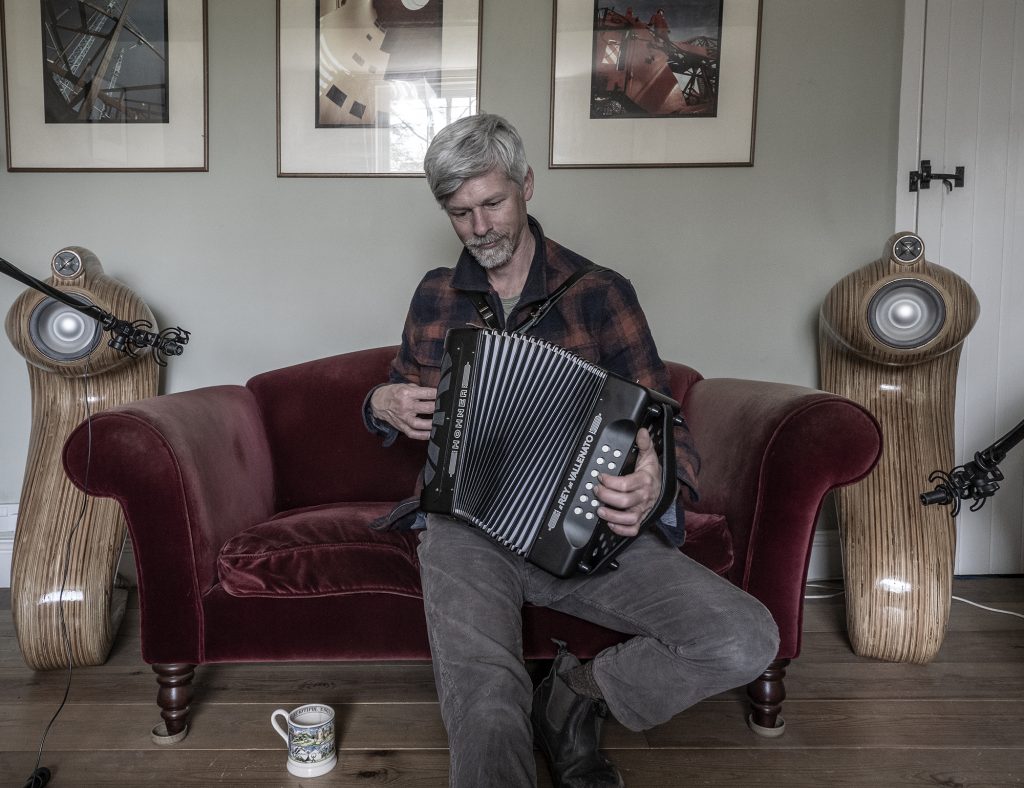
Conclusions
It’s not that easy from some fairly quick and dirty samples to draw too much in the way of conclusions. For example, the AKG CK92 doesn’t sound too great on the guitar, but, from much wider experience, I’d rather tackle music recording with the CK92 than either the EarSight or the Clippy mics: it was a poor (small) room, mediocre instrument, and less than ideal placement. But what can be drawn from these tests is that the EarSight mic is sonically very close to the Primo EM172/272-based mics; in this case Micboosters Clippy, but, equally, the LOM Uši Pro and other mics with the same capsule. It doesn’t have the issue with wifi RFI that can affect the EM272 capsule, and is much more sensitive. For those recording all but the loudest nature/ambient sounds then this is a real positive, especially – as is so often the case – if recording with less than stellar preamps: with the excellent MixPre-3 this was not significant, but with a handheld recorder this would really tip things in favour of the EarSight mics (or any made with the same capsules). So it is a useful addition to the ranks of small, cottage-industry assembled mics from pre-existing capsules. Given that the Clippy P48 mics are currently £125.94 a pair and the (seemingly always sold out) LOM Uši Pro mics are €130.00 a pair, it looks as if the EarSight mics are something of a bargain.



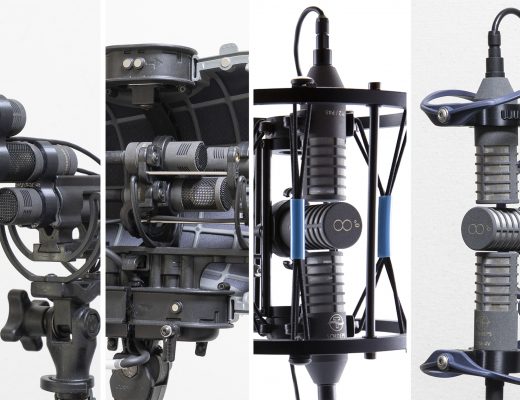
18 Comments
Great article! I have a set of the clippys, LOMS Usi and Earsight and I enjoy them all. I find the extra sensitivity of the Earsight really useful. Thanks again for your insights 🙂
Thanks Andy. Yes, the EarSight sensitivity is remarkable (not that the EM172/272 is insensitive).
Hi,
Great article and was really informative (especially about the RFI topic). I was wondering if you could share more on the enclosure that you placed the Earsight mics in to give it a larger diameter. Seems that in helps fit the mics better in the Rycote shock mounts. Thank!
Thanks Hix. Not much I can add to what I have said in the blog post about the plastic collar that Immersive Soundscapes provide with the mics, other than it is 3d printed: like many such 3d-printed things the collar is a bit primitive looking, but it is absolutely fine, fits well and does the job of increasing the diameter if needed.
Hi Roland !
Thank you for this nice and very informative article !
I personally own the clippy EM272s and these Earsight microphones, both 3.5mm plug-in-power versions, and i should mention that your conclusion applies the same way.
In my tests, the Earsight are about 4 to 5dB more sensitive than the clippy EM272s, delivering a bit deeper bass, little less low-mid, clear natural mid, and slightly less highs. Also, their self noise appears to be slightly lower, which is noticiable for quiet recordings.
In my opinion, at €75.00 currently (+ postage), these microphones are really worth it !
Thanks Kevin. Interesting that you were getting a more modest – and, indeed, more as expected – difference in sensitivity between your EM272 and the Earsight mics: perhaps my old EM172 mics are out of spec! Yes, the Earsight mics are good value.
Kevin, have you or anyone you know of, tested any of these mics in humid conditions. I am very invested to how they react to high humidity and what the differences are between them. thnks, John
Hi John,
Not sure if you really meant this for Kevin (the previous poster of a comment) or me? Anyway, I haven’t tested the EarSight mics in especially high humidity: I suggest contacting the maker, Philippe at Immersive Soundscapes, to see if he can point you to any relevant test. Likewise no extreme such tests with my EM172 and EM272 capsuled mics. That said, electret mics such as all these shouldn’t fare too badly in such conditions. However, if recording in extreme humidity – esp. if going to the expense of travel – you would be safest with an RF condenser mic: if wanting a small humidity-resistant omni, then the Sennheiser MKH8020 would be your best bet. Rather pricier than these AOM-5024L-HD-R and Primo EM172/272 capsuled mics though!
Cheers,
Roland
Interesting one Roland. Good review!
Thanks Jake!
Thanks for this review and I bought a pair of earsights a month or so ago after reading it. I’m very happy with them after some extensive use. To my ears they are very clean and have been great in recording delicate ambiences in the desert and woods.
The one pickle about them is their size–specifically their diameter. None of the clips I use with lavs fit these. Any suggestions for good clips so I can attach these to twigs, dowels, hats, etc?
Thanks Charles. Glad you have got on well with the EarSight mics. Not sure I have any great ideas about clips: I’ve just tried my Clippy clips and they are too small. Perhaps best to email Philippe at Immersive Soundscapes direct as he might well have ideas.
Cheers,
Roland
I use them since one month. Good sound, sensitivity. Not anyone humidity problem. My dream: one 8 figure primo capsule for a MS aray.
jielkade – Baden-Baden Germany
Roland, I know this review was done some time ago, but I just discovered it recently and it helped me decide to order a matched pair of Earsight Thumb BBG units from Immersive Soundscapes. Phillipe was very prompt and the mics are great. Assuming your detective work regarding the use of the AOM-5024L-HD-R capsule in these mics is correct, and for those interested in more details, I found the following spec sheet at the capsule manufacturer’s web site. It includes humidity test data that John was asking about:
https://api.puiaudio.com/file/8a1a7f37-cd74-49b0-81f3-f74090655669.pdf
Hi Todd. Glad the review helped, and that you like the mics. And, yes, Philippe confirmed he uses the 5024 capsule, so the spec sheet you have linked is very much relevant.
Cheers, Roland
Roland, that’s great news, that Phillippe has confirmed this is the capsule in question. Thank you for that!
-Todd
No problem Todd. I have just edited the post to show that Phillippe confirmed that this was the case back in 2022. Thanks for raising this.
Cheers, Roland
[…] Ltd (Micboosters) in the UK, LOM in Slovakia, Oaka Instruments in the UK, and Earsight in France (which I have tested previously). In my case, I chose a pair of the Clippy mics made by FEL/Micboosters, who also sell capsules and […]